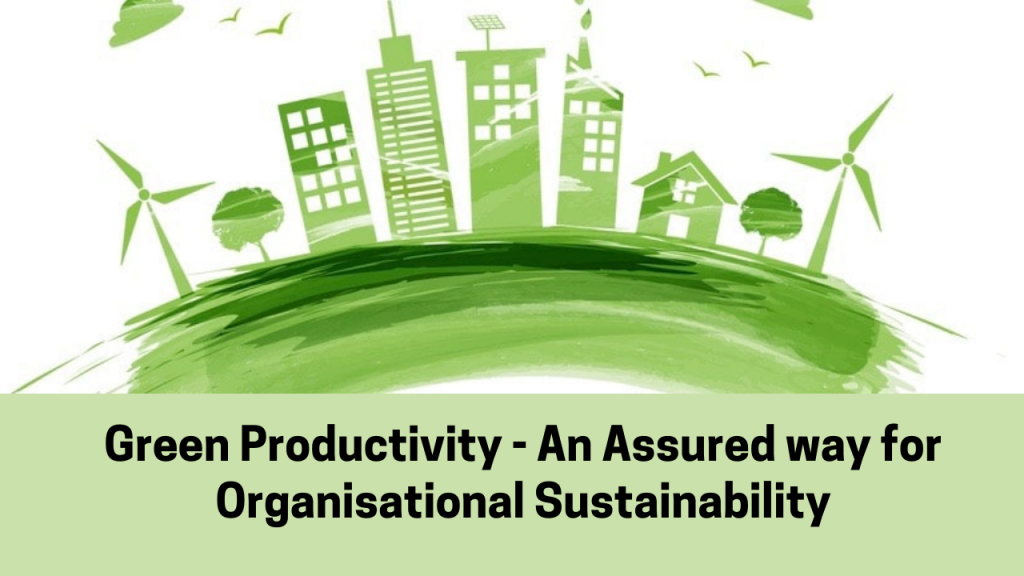
Introduction:
Right from the School to Sustainability summits, environment sustenance is being emphasized. The environment connects the whole world irrespective of geography, politics, or any other barriers. The growing digitization has converted the world into a business village, yet the real connection is the common environment we live in.
Through the interaction with the global leaders of the environment, we understood that the air pollution in one location gets carried over a long distance irrespective of the country’s boundaries. The Sustainability summits, therefore, call for global commitment to minimize the impact of industrialization on the environment. SDG – sustainable development goals also address environmental issues. Hence, the concept of control at the source must be deployed to minimize the losses.
If productive green growth is the focus, no one will deny the need for industrialization. Asian productivity organization headquartered at Tokyo has initiated the programs on green Productivity and national productivity councils across 27 countries are creating awareness of the concept
Methodology of Green Productivity
The common factor irrespective of different product line, scales, services these units are subject to concern the environment & Productivity. Units having initiated & successfully completed Green Productivity projects for improvising productivity & reducing cost, creates a very positive socio-economic impact.
The methodology can be based on ISO 14001(energy management system), ISO 14051 (material flow and cost analysis -MFCA), ISO 50001(Energy management system), ZED (Zero defect & zero effect), or ISO 9001(Quality management systems) or any improvement methodology of 12 steps of QC, 5 steps of DMAICtools & techniques. As a part of continual improvement, any progressive organization irrespective of certification can take up such projects. In fact, the projects can be deployed at home also.
Any improved method such as 3 M – Muda, Mura, Muri for reducing the environmental impact and material waste can be taken up as a green productivity project if these tools are used for the cause of environmental impact reduction. The typical tools used in productivity and environment management can be used for similar projects. The analysis, improvements, sustaining the change, or better version is monitored, and such case studies can be published in proper forums, for the cause.
Objective:
GP technique is a method of performance and work improvement, applicable to people, processes, equipment, materials/energy, products, and wastes. GP techniques are rather focused on the generation of GP options.
The objective of this article is to appeal to all readers to invite the success stories, or develop interest & initiate the projects, to get data for research and further improvisation as well as trigger brainwriting for ideation on the common platform to all stakeholders on this platform.
Organizations can use this drive as the supplementary drive for any management system certification or business excellence, or even as a standalone improvement drive.
Implementation of Green Productivity:
- The implementation of Green Productivity is based on the data and information shared by the organisation with their perceived problems.
- After analysis the specialist develops the projects and classify them as short term & long term.
- Based on the budget and time span one can prioritise and start implementing the project.
- Again, the results are validated in terms of productivity improvement, cost saving, waste reduction and employee engagements with help of data.
It starts with training, followed by team formation in the form of data collection, analysis, and solution prioritization based on GP options and weighted criteria evaluation. Implementation, knowledge sharing, in turn promoting the concept once it is executed and validated.
Tools and Techniques:
Tools used are simple like material balances, energy balances, eco-mapping, check sheet, material flow accounting, Ishikawa diagram, Pareto which are even used for SPC, or QC, Kaizen concept by even operators.
Tools for Problem Definition:
Problem definition is data-based so is solution evaluation on economic feasibility. Tools are
- Brainstorming
- Process flow diagram
- Material & energy balance
- Concentration diagram
- Eco mapping Team formation
- Walk through survey
- Identification of problem,
- Option generation Walk through survey,
Tools for Problem Identification:
- Walk through survey
- Ishikawa diagram
- Pareto Chart
Steps Involved in Green Productivity Implementation:
- Training and Awareness
- Objectives and Target setting
- Prioritization of options tools is – Cost benefit analysis
- Weight scale assessment
- Screening and evaluation of GP options
- Implementation plan with Critical path method.
The Productivity Aspect
Benchmarking is a process of measuring the performance of a company’s products, services, or processes against those of another business considered to be the “best in class” in the industry. The goal for green productivity is benchmarking with self or leaders.
Benefits of GP Training and Awareness Program
- Industrial Field Visits to identify Waste Prevention areas
- Good Housekeeping or improvement opportunities
- Improved Operating Procedures
- Waste Segregation
- 5S Technique Resource Conservation
- Recycle / Reuse / Recovery
- Off-site recycling
- On-site Recycling
- Energy Conservation Process Modification
- Input Material Changes
- Process / Equipment Changes Management of Waste
- Air Emission Control Wastewater Management
- Solid Waste Management Product Improvement
- Design for Environment – 3 R- Advantages of Waste Segregation
- Ease in end-of-pipe treatment of a non-compatible pollutant stream.
- Increased possibility of recycling / reusing a waste stream. E.g., for Electroplating wastewater, degreasing wastewater followed by segregated Nickel Rinse water & Chromium rinse water can lead to Possible Nickel recovery & Possible chromium recovery, so is GP project with simple solutions.
Green productivity is a vital strategy to balance economic growth and sustainable development of an organization and the nation. Hence, a small, and medium business can make use of its tools and techniques to achieve a competitive advantage and profitability by reducing the environmental impact. In that context, I hope this article was useful to you to know the importance, methodology and tools & techniques of Green Productivity.

